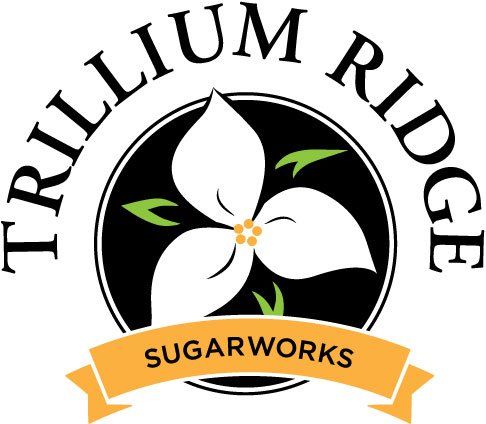ARTICLE
TRILLIUM RIDGE SUGAR WORKS
Maple syrup, our first taste of spring
From The Napanee Beaver
By Ross Less
Staff Reporter
"Mah-Kwan Kadeek", from the language of the Maliseet Indians of New Brunswick, translates to "the place where maple sugar is made." Mah-Kwan Kadeek is located on the 8th Concession of Tyendinaga Township at RR1, Shannonville, and is owned by Terry Gervais and his family.
Now consisting of 309 acres, 2,700 tapped trees and 5,300 taps, Mah-Kwan Kadeek was not always this large or productive. As a matter of fact, the snug little sugar shanty nestled among the syrup-producing maples on the farm today might even be termed downright luxurious from its humble beginnings 11 years ago.
Terry Gervais can't help but express pride at the way his humble hobby has blossomed into a sweetly-successful business, a business that is a marked contrast to Gervais' everyday business, serving food and renting equipment in Toronto. Gervais owns his own restaurant and also rents equipment for catering, but his boyhood dreams as a Boy Scout were answered 11 years ago when he purchased 230 acres of property from Joe Daily.
This 43-year-old entrepreneur has steadily improved and enhanced his maple sugarbush and shanty to the point where his first year's tapping looks positively to current production. His original year in the maple syrup business saw him place 275 taps and produce 110 litres of syrup from a very small, thrown-together shanty that barely housed his make-shift boiling equipment. This year, even as he collects the sap from his trees, he is again expanding his shanty.
The vacuum system takes away a lot of the tripping through the bush to gather the sap. The negative pressure created in the system pulls the sap out of the trees, when it is running, like a vacuum cleaner. A pump, located within the system, pumps the sap to a tank above the two evaporators connected in series in the shanty.
The sap passes through both evaporators, becoming thicker as the water is boiled out of it. Instead of "taking the syrup off" in the second evaporator, Gervais transfers the thickening syrup to a smaller, propane-heated evaporator that provides better control for the final boiling of the syrup. The hustle and bustle around the shanty appears relaxing to Gervais and his family. Everyone has their job to do, but all seem to enjoy the freedom and honest labor required to make their world-renowned product.
"It's a change of pace from the business in Toronto," Gervais says as he sips on a cup of coffee made from distilled water from the evaporators and sweetened with his own maple syrup. Most Indians living near the inland waterway of the Great lakes and the St. Lawrence Valley produced maple sugar as their basic source of sweetener many years before the Europeans arrived. An Indian male was usually in charge of boiling sap, while his wife and children assisted by gathering wood. Sap was placed into hollowed basswood logs. Hot stones were then placed into this sap, causing it to evaporate. Forty drops of sap made one drop of syrup. From birchbark containers and long troughs to wooden buckets and iron kettles, to plastic pipelines and modern evaporators, maple syrup remains as it always has been... our first taste of spring. Reproduced from the tag on all Mah-Kwan Kadeek syrup.
